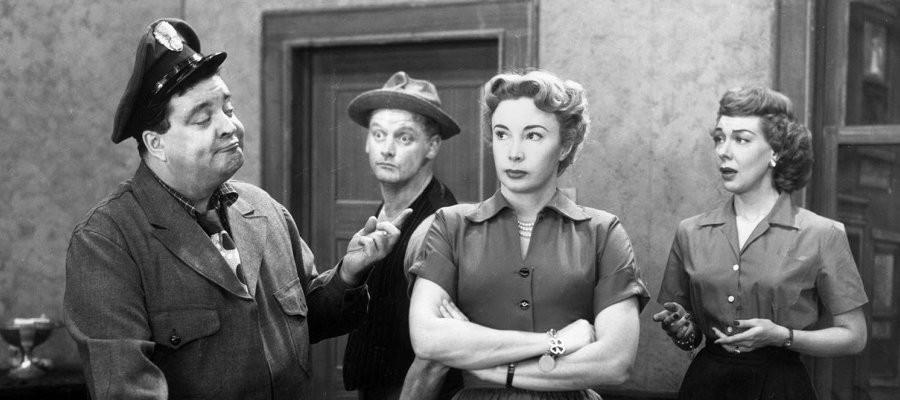
The Creature
1955 - United KingdomSandwiched between The Quatermass Experiment and its sequel Quatermass ll, was Nigel Kneale's gripping tale of a party of explorers who arrive in Tibet, in search of the legendary Abominable Snowman. The story was inspired by the then-current craze for establishing the existence of the Yeti. During the 1950's there had been extensive searches of the Himalayas, and in 1954 one particular Fleet Street newspaper had dispatched a team to track the creature down.
In this dramatization, a party of explorers, led by Tom Friend (Stanley Baker), arrive at the Rong-ruk monastery because one of their number, Andrew McPhee (Simon Lack), had claimed to have seen a Yeti's footprints in the snow on a previous expedition. Friend's motives for finding the creature are commercial rather than scientific as he is hoping to trap it and put it on display, which will in turn make him his fortune. They are joined by botanist Dr John Rollason (Peter Cushing) who is investigating some 'special evidence' that he claims to have found purporting to the creature’s existence.

Kneale's script draws together elements of mystery, suspense, betrayal and the supernatural as the expedition encounters more than they have bargained for. After they kill a yeti the men are attacked one by one by the other creatures, who use telepathic powers to kill them. The only one who escapes is Rollason, by virtue of the fact that he has not threatened the yeti. On returning to the monastery he informs the Lama (Anold Marlè that the yeti does not exist and theorises that "It isn't what's out there that's dangerous, so much as what’s in us."
Kneale had himself written a foretaste to the setting of The Creature in that week's Radio Times magazine: 'During the past half-century, exploration of the great Himalayan mountain chain and the neighbouring territories has been greatly intensified. European expeditions have ranged through the highland states of Nepal, Bhutan, Kashmir, sometimes even into the 'forbidden land' of Tibet itself. They came upon little-known ways of life: communities that were snow-bound through much of the year, ruled by lamas, the priests of Tibetan Buddhism and other, older cults; where it was forbidden to take life in any form, yet where human skulls were used to make instruments for ritual music. They found a land of contradictions, of eternal peace and sudden cruelty, of great beauty and the bitterest, most hostile living conditions man had to endure. Not far above the last lonely settlements came the perpetual snowline, beyond which there were no seasons - only eternal winter in the gale-swept heights. Surely no living thing could live there?'
Kneale's introduction continues by mentioning 'strange reports' from climbing parties of 'footprints found in the snow at seemingly impossible altitudes' and of outlines of 'very large, naked feet' before concluding, 'does the yeti exist? If so, what can it be? The Creature, in purely fictional terms, is a guess at the answers.'
Unusually for this period, the BBC allowed the production to take in expensive location work for filmed inserts of exterior scenes. The Swiss Alps doubled for the Himalayas whilst the BBC's recording studios at Lime Grove were used for the live transmissions.

Both critical and viewer reaction to The Creature was mixed. The Stage was particularly critical of the play: 'Rudolph Cartier tried valiantly to make it all convincing, but he could not combat the banal dialogue. The gallant explorers, who made surprisingly light of the weather conditions, were like schoolboys out on a spree. Taken as a schoolboyish adventure, in fact, it was enjoyable enough in its way, and the cast acquitted themselves with credit. Peter Cushing, his style a model of television acting, headed an excellent team comprised of Stanley Baker, Eric Pohlmann, Simon Lack, Wolfe Morris and Anold Marlè.’
Leslie Ayre, TV critic in the Liverpool Echo did not agree; 'In the past it has often happened that, when TV drama has attempted something ambitious and unusual, one has applauded a brave effort while being compelled to point out that unfortunately it did not come off. Last night they took us to the Himalayas for Nigel Kneale's play, "The Creature," which dealt with an expedition in search of the Abominable Snowman. And I thought they brought it off very well. Author, actors and technicians did a thoroughly intelligent job. I can recall few more successful examples than this of producer Rudolph Cartier's of the mingling of film with scenes shot in the studio. There were many moments of genuine tension, and, in a good all-round cast, we had first-rate performances by Peter Cushing and Stanley Baker.' Clifford Davis of the Daily Mirror was even more enthusiastic: 'Last night's offering was gripping stuff and, for this viewer, packed with terror.'
Peter Cushing, incidentally, was chosen by the vote of 60 TV producers as the outstanding television actor of the year for 1955 (Virginia KcKenna won the outstanding actress vote).

Two years later the writer adapted his script for the large screen in the 1957 Hammer/Clarion production The Abominable Snowman. Peter Cushing reprised his role from the original TV play, which was broadcast live by BBC television on 30 January 1955 with a second live transmission on 3 February. No recordings were made and consequently the movie version is the only one that survives. However, there were numerous changes from the original TV script -including character name changes and two new characters, including John Rollason's wife, who had only been referred to in the original script as 'missing presumed dead'.
Seen this show? How do you rate it?
Seen this show? How do you rate it?
Published on January 11th, 2022. Written by Laurence Marcus (29 September 2002) for Television Heaven.










